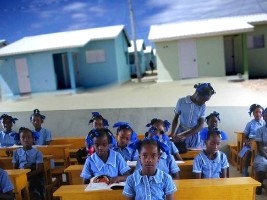|
||||||||||||||||||
|
|
Haiti - Social : The growing political instability threatening the sustainability of social progress 31/12/2014 08:55:18
The study detected five trends summarizing how Haiti is doing in terms of achieving its development objectives: 1. Between 2000 and 2012, the percentage of people living in extreme poverty —with one dollar or less a day— dropped from 31% to 24% at the national level, and from 20% to 5% in Port-au-Prince. More than 200,000 people have climbed out of poverty. 2. School enrollment increased from 78% to 90%, very close to the goal of universal child enrollment. However, many children abandon school or have to repeat years. Less than 60% reach the last year of primary education; and low educational achievement is one of the main factors behind unemployment. Compared to its Latin America and the Caribbean neighbors, Haiti has the greatest ratio of adults without formal education. The report recommends a financial plan to improve educational access and quality, focused on early childhood development. 3. Despite this, a high degree of vulnerability threatens these improvements: Close to 2.5 million Haitians are unable to cover their basic food needs, while one million are in danger of falling into poverty. Improvements in poverty reduction were mostly driven by international aid (following the earthquake), remittances and an increase in well-paid jobs in construction, transportation and telecoms, sectors that also received a significant amount of investment from the international community as part of the reconstruction process. "Haitians needed money, families abroad wanted to help their relatives here in Haiti," explains Sharline Dubuisson, whose money transfer company saw a spike in demand after the earthquake. Seeing that foreign aid is starting to slow down after an exceptionally high period following the disaster, social indicators could be easily reversed if efforts stops and if growth does not resume. Haiti has recently expanded its main social security networks, but its coverage is still very low. Barely 8% of all Haitians received non-contributory social assistance benefits in 2012, while even less salaried workers have access to social security. 4. Haiti continues to exhibit the greatest income inequality in the continent, and is one of the most unequal countries in the world. The richest 20% of households earn 64% of the country’s total income, while the poorest 20% makes do with just 1%. 5. There is a growing gap between Port-au-Prince and the rest of the country. More than 80% of those living in extreme poverty do so in rural areas. Families in the north and southwest of the country work hard to grow food, but they fail to earn enough. Extreme climatic events, lack of fertilizers, pesticides and seeds, and limited market access are just some of the impediments they face. This profound urban-rural gap can be observed when looking at access to services. Only 16% of people in rural areas have access to improved sanitation, compared to 48% in the cities. For many families, migration is seen as a way out of poverty. During this period (2000-2012), 20% of the population migrated within the country. For example, educated migrants working in Port-au-Prince on average earn between 20% and 30% more than if they had stayed in their town or city of origin. While the country continues to work to close the poverty gap, the report recommends three main courses of action : Creation of jobs ; Increased access to health and education, and Protecting the poor and most vulnerable from unexpected economic events. In a context of limited resources, the fight against poverty can only be possible when decisions are taken with the best available information. Because of this, this report on poverty in Haiti is a tool that will allow governments and donors to be more specific in their programs and be able to reach people in need. HL/ HaitiLibre
|
|
|
Why HaitiLibre ? |
Contact us |
Français
Copyright © 2010 - 2024 Haitilibre.com |



